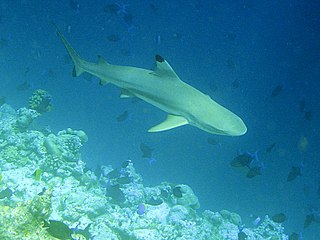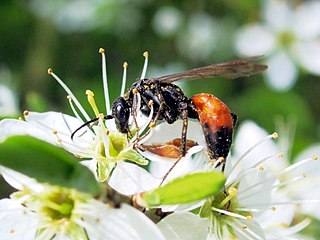
Requiem sharks are sharks of the family Carcharhinidae in the order Carcharhiniformes. They are migratory, live-bearing sharks of warm seas and include such species as the bull shark, lemon shark, spinner shark, blacknose shark, blacktip shark, grey reef shark, blacktip reef shark, silky shark, dusky shark, blue shark, copper shark, oceanic whitetip shark, and whitetip reef shark.

The Scoliidae, the scoliid wasps, are a family of about 560 species found worldwide. They tend to be black, often marked with yellow or orange, and their wing tips are distinctively corrugated. Males are more slender and elongated than females, with significantly longer antennae, but the sexual dimorphism is not as apparent as in the Tiphiidae.

Carpet sharks are sharks classified in the order Orectolobiformes. Sometimes the common name "carpet shark" is used interchangeably with "wobbegong", which is the common name of sharks in the family Orectolobidae. Carpet sharks have five gill slits, two spineless dorsal fins, and a small mouth that does not extend past the eyes. Many species have barbels.

Oecobiidae, also called disc web spiders, is a family of araneomorph spiders, including about 100 described species. They are small to moderate sized spiders (about 2 to 20 millimetres long combined head and body length, depending on the species. Larger ones tend to be desert-dwelling. The legs are unusually evenly placed around the prosoma; most other spiders have some legs directed clearly forward and the rest clearly backward, or all forward. The first two pairs of legs of many Oecobiids point forward then curve backwards; somehow in a running spider this gives a curiously scurrying, wheel-like impression that is characteristic of many Oecobiidae, and is helpful as a rough-and-ready aid to identification in the field. Characteristic of the family is the anal gland; it bears a tuft of long hairs. Typical colour patterns range from dark-patterned cream in some smaller species, to a small number of symmetrically-placed, conspicuous round light spots on a background that may be anything from a dull orange colour to black. The carapace is rounded and bears a compact group of six to eight eyes medially situated near the front of its dorsal surface.

André Jean Baptiste Robineau-Desvoidy was a French physician and entomologist specialising in the study of Diptera (flies) and to some extent of the Coleoptera (beetles).

The genus Eligmodontia consists of five or six species of South American sigmodontine mice restricted to Bolivia, Chile, and Argentina. Species of Eligmodontia occur along the eastern side of the Andes Mountains, in Patagonia, and in the Chaco thorn forest of South America. They can be found in arid and semiarid habitats and in both high and low elevation areas. These rodents are commonly known as gerbil mice or by their local name lauchas. Sometimes they are also called silky desert mice, highland desert mice or silky-footed mice. The closest living relatives are probably the chaco mice (Andalgalomys), the leaf-eared mice, and Salinomys.

Léon Jean MarieDufour was a French medical doctor and naturalist.

Malimbus is a genus of birds in the family Ploceidae. It was erected by the French ornithologist Louis Jean Pierre Vieillot in 1805.

Pytilia is a genus of small brightly coloured seed-eating birds in the family Estrildidae. They are distributed across Africa.

The brown-tailed mongoose, brown-tailed vontsira, Malagasy brown-tailed mongoose, or salano is a species of mammal in the family Eupleridae. It is endemic to Madagascar. Its natural habitat is moist lowland tropical forest. It is threatened by habitat loss.

Phalangium is a genus of harvestmen that occur mostly in the Old World. The best known species is Phalangium opilio, which is so common in many temperate regions that it is simply called "harvestman".

Formica sanguinea, or blood-red ant, is a species of facultative slave-maker ant in the genus Formica characterized by the ability to secrete formic acid. It ranges from Central and Northern Europe through Russia to Japan, China, the Korean Peninsula, Africa and also the United States. This species is coloured red and black with workers up to 7 mm long.

Enidae is a family of air-breathing land snails, terrestrial pulmonate gastropod mollusks.

Pycnothelia is a genus of lichen-forming fungi in the family Cladoniaceae. Pycnothelia was promoted to generic status by French naturalist Léon Jean Marie Dufour in 1821; it was originally circumscribed by Erik Acharius in 1799 as a section of the now-defunct genus Cenomyce.

Priocnemis is a genus of pepsine spider wasp containing around 30 species.
Sphaerularia vespae is an endoparasitic nematode that infects the Japanese yellow hornet, Vespa simillima. It invades and resides in the gaster (abdomen) of female hornets where it grows and develops. Because S. vespae sterilizes its host, it is also known as a parasitic castrator. After S. bombi, it is the second recognized species of the genus Sphaerularia.

Ischnocolus is a genus of tarantulas that was first described by Anton Ausserer in 1871. This tarantula genus includes some of the smallest in the family.

Arocatus melanocephalus, the elm seed bug, is a true bug in the family Lygaeidae. The species was initially described by Johan Christian Fabricius in 1798, and Maximilian Spinola designated it to be the type species of the genus Arocatus in 1837. This bug is native to Europe but has been introduced to North America.

Byrrhus is a genus of pill beetles in the family Byrrhidae. There are at least 30 described species in Byrrhus.

Henestaris is a genus of mostly European bugs, it is typical of the subfamily Henestarinae.


















